The nine papers framed the Summit’s three thematic clusters: technological, social, and change process factors. Highlights of each paper were presented, responded to and then discussed by the participants.
First, authors gave a nine minute summation of the key points of their paper. Each author had a poster of an icon or image that was illustrative of the main concept of his or her paper. Participants were given a pad of Post-it notes. During the author’s presentation, they jotted down ideas, questions, “ah-hahs” on the notes, and a runner stuck them to the presenting author’s image.
Then, the nine respondents shared their reaction to the papers. The floor was then opened to discussion by all invitees. Attendees continued to jot down ideas, questions, and “ah-hahs.” At the close of the session, the authors stood by their icons/images and the attendees were able to ask questions and discuss their comments with the authors.
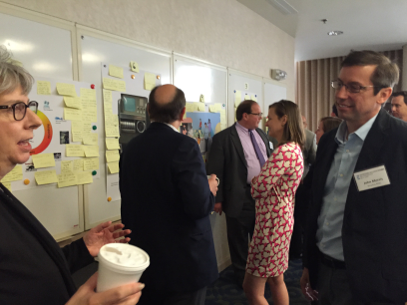
Some common themes derived from day one’s presentations and discussions included:
- Distinctions between the able and differently abled will decrease due to embedded technology.
- The paradox of privacy in a connected world.
- Performance enhancement/hyper abilities.
- Interoperable technology and interoperable User Experience.
- “Another AI,” second consciousness, Assistive Intelligence.
- Autonomy - understanding of user preferences, not just needs – human agency.
- Transparency – transparent, usable, affordable.
- Policy Divide – tech solutions, will policymakers fund it, approve it, regulate it?
- Pro-sumption and co-design.
-
Wearable devices as sensors.
Technological Factors
The Future of Mobile Consumer Technology for People with Hearing Loss
Authored and presented by Richard Einhorn, Einhorn Consulting, LLC
![]()
Extended Abstract: People with hearing loss, some 48 million Americans, have a severely reduced ability to extract desired sound information such as speech or music from background noise. The consequences are severe, ranging from extreme social isolation to a significantly higher risk of dementia and other physical diseases.
While hearing loss is undoubtedly a medical problem with no biological cure likely within the next 15 years, hearing assistance is essentially an acoustic problem. Present-day hearing aids consist of very small microphones, digital signal processors, and loudspeakers worn on (and in) the ear. Although they are convenient and unobtrusive wearable technology, hearing aids often do not significantly improve speech comprehension in many real world sound environments due to several design constraints, including less than optimal microphone placement. Thus, even modern hearing aids are used by a small segment of the population that could benefit from them.
Wireless headsets and smartphones typically include larger microphones, bigger batteries, and more sophisticated audio processing capability than hearing aids. By linking such devices together and adapting them for hearing assistance, it is possible for mobile consumer technologies to minimize background noise and improve speech comprehension in many live situations. Future wireless technologies will permit the networking of microphones in multiple mobile devices, improving hearing comprehension even when it is extremely noisy. As a result, many people with hearing loss may be able to hear as well as, if not better, than their normal-hearing companions.
This new hearing model is close to a classic “paradigm shift,” disrupting and challenging conventional orthodoxy on hearing assistance. Currently, a trained audiologist meets patients in person, tests their hearing, and then programs their hearing aids, an expensive and time consuming process. In the future, most patients will simply run a smartphone app that automatically tests their hearing for them and configures affordable earpieces that wirelessly pair with their smartphones. Typically, fine-tuning will occur over the Internet rather than in person during time-consuming office visits.
Such dramatic changes to the current hearing assistance model will create numerous challenges. Manufacturers’ high margins are likely to drop. Audiologists will need to redefine their role as hearing specialists or risk being side-lined by automated, cloud-based diagnostic and fitting algorithms. App designers may create difficult-to-use interfaces. The way people are trained to use hearing devices will need to change. Separate companies in the hearing industry may choose to retain their proprietary wireless protocols for connecting devices together rather than seek a common standard. This could easily lead to compatibility problems between different brands, customer confusion, and continued underuse of hearing technologies. In addition, regulations may limit innovation and consumer choice.
Despite the challenges, companies in the future will find ways to leverage consumer level mobile technology to create affordable, more reliable, more effective, and less stigmatizing hearing assistance, enabling millions to hear and communicate with friends, co-workers and the people they love.
Participant Notes
For this paper, participant’s considered how the technologies discussed would be regulated and how the current system would be transformed by allowing for the user to configure their hearing technology, as opposed to an audiologist. Below are some notes to the author:
- Mastoidal conduction.
- OEMs already working on this solution.
- Great idea to break the wire.
- Would regulatory agency regulate the software app? What if app developer is very small?
- Stakeholder resistance to change >>> audiologists.
- Also consider individuals who do not want to “correct” their hearing – eg, deaf community want to use sign language.
- Wearable directional microphones.
- Disruption of traditional systems of care.
- New fields – oral rehabilitation regulatory change.
- Advanced directional microphones pose privacy threats – private conversations will be a thing of the past.
- Not just for hearing loss? Also hearing enhancement in a noisy environment.
- “Medical conditions may be missed” > probably not, with concurrent rise of health sensors and health apps.
- Increasing ability for users to tailor entire sensory suite – all incoming senses, filtered.
- Wearable and fashionable.
- Requirement for common technical standard for wireless interface – not tied to one manufacturer.
- De-stigmatize.
- Collapse of traditional hearing aid industry (parallels collapse of the Polaroid camera market).
- Audiologists play greater role in the training of solutions.
Technology-Based Assistive Sensory Transformers
Authored and presented by Helen Sullivan, PhD, Rider University
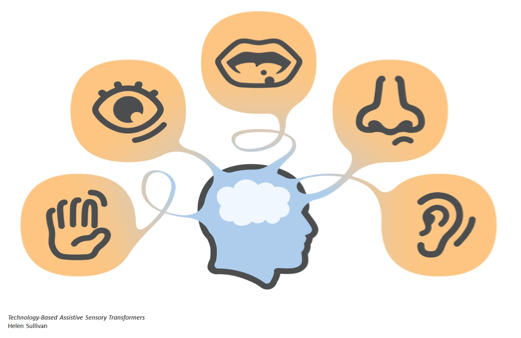
Extended Abstract: One thing we can count on is that technology is in constant change; in the past the iterations appeared less rapid than today’s regular stream of new technological innovations. We can gauge potential changes in the future by recognizing key transitions from one technology to another.
We will focus on what technologically influenced changes can be expected for people with disabilities, such as for people who are deaf and hard of hearing. One challenge faced by people who are deaf is an inability to recognize events in their environment cued by sounds. The hearing aid is technology that enables reception of these cues for those with some hearing, but the relatively recent ubiquity of smart phones, tablets and apps enables intelligent signal processing and alerting. Thus a key enabling change is the addition of apps that augment human senses, via a technological platform such as mobile phones or tablets.
In the future, whether the devices utilize apps, or more likely become a platform of personal services and functions that is seamless, they will have the capability to serve as sensory transformers or substitution mechanisms. Individuals with impaired or no hearing may use the devices to communicate with others using sign language, via a camera and gesture recognizer; obtain updates for their digital cochlear implants, upgrade or improve the software to allow for enhanced hearing; or transform the spoken word into text narratives. With wearable technology, such as Google Glass, spoken dialog can be transformed into text captions visible only to the wearer. Students in the classroom who are deaf or hearing impaired would have barriers removed or significantly lowered by utilizing wearable speech processors that provide captions.
Today’s simple vibratory feedback will evolve into sophisticated haptic interfaces to serve as a substitute for hearing, transforming environmental sounds into tactile cues. While the deaf may currently use a vibratory alarm in their pillows for fire or urgent notification, the potential exists to use vibrotactile cues to transform sound qualities, directionality and rhythm. Currently digital pedometers, used to monitor daily exercise also track hours asleep, heart rate, calorie intake, water intake and more. These devices provide vibrations on a wrist band to serve as notification of reaching a goal and allows for repurposing the wrist-borne vibrator to generate “silent” alarms to awaken the wearer. Such wearables are only the tip of the iceberg. Whether information is generated by the user, reporting health data gathered by wearable devices, or received from outside sources, and then passed from person to person, for conversation, interaction with medical staff, or between students and teachers, we anticipate continued miniaturization and blending of technology that will place the focus not on the technological tool, but on the task that the user wishes to accomplish. This trend will integrate ever more sophisticated technologies into devices we use and wear, linking more technological platforms, and evolving an elegant simplicity of use. Current day, effortful techniques will transform, blurring the lines of what is biologically synchronous technology and what is actually part of our human body.
Participant Notes
For this paper, participant’s considered how the technologies discussed could impact the stigma associated with different disabilities. Below are some notes to the author:
- New stigma for a “new sense.”
- How might this new technology affect the disability culture – especially “the Deaf”?
- Hyper-hearing.
- If we go smaller with everything, it’s hard to use for older adults and those with fine motor problems.
- Environment and wearable / mobile understands the context of need.
- Great technology! What happens in the future? Where do we go?
- Couldn’t these technologies be useful for those without disabilities too?
- Shift from qualitative / sensory understandings to quantitative / data-based.
- What happens if assistive ‘ware is hacked?
- Possible to destigmatize disabilities because no-one can see what you’re using your iPhone/iWatch/Fitbit for….
- New haptic language?
- Bodily sensations to augment other senses.
- Steep learning curve for alternative sensory input (e.g., cochlear implant) – especially for people with cognitive impairment.
- Leverage existing technologies already in smartphones – here now.
- Bionic effects – “cellphone cyborgs.”
- Information transformation – simpler text. Add > symbols (non-text).
- Interactive innovations – gesture / speech control.
- Technology adapting media – privacy and security concerns.
- Immersive supportive environments throughout homes and businesses – Amazon Alexa (Amazon Echo) – summon assistance through voice or gesture commands (see “Iron Man” movies – Jarvis).
- Impaired population very diverse – some have much greater challenges which may not easily be aided with technology.
- It’s not about device size – it’s about the accessibility of the I/O.
- How might smart systems in homes transform caregiving?
- VEST – “Versatile extrasensory transducer” – uses sense of body to map cochlear patterns on body.
- Language and thought assists – possible futures for managing verbal or cognitive input or output for those with dyslexia, dementia, other cognitive impairment.
- Implantable Augmented Reality.
- Improving communications with groups and individuals.
Robot-Human Collaborative Learning Communities: The Future of Innovative Accessibility
Presented by John Bricout, PhD, University of Texas - Arlington Authors: John C. Bricout, PhD; Bonita B. Sharma; Paul M.A. Baker, PhD; Aman Behal
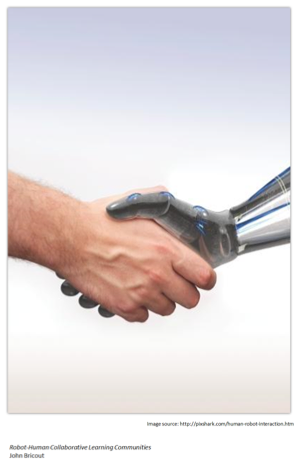
Extended Abstract: The information age in general, and the digital age in specific, offers new opportunities for learning that builds on the possibilities of non-physical connectivity while bypassing barriers posed by the physical. For people with disabilities, the tension between the two has been a concern often downplayed, almost as if by unwritten agreement, with strong implications for access to social goods such as education, employment, recreation and political participation. Perhaps more than any other facilitative technology, “socially assistive robotics (SAR), a new field of robotics that focuses on assisting users through social rather than physical interaction ,” represents a ground breaking development at the intersection of physical and non-physical learning. Hence, SAR offers a unique approach for significantly increasing the capabilities, and hence the social participation of people with disabilities. Emergent trends in augmentative technologies point to at least three inclusive future scenarios with accessibility cross-cutting digital and physical spheres of knowledge and action.
Digital communities populated by SARs and human users can spur accessibility by collaboratively creating a joint space for learning and exchange, unbound by physical constraints. SARs can dialogue with users in communities of interest, networked within broader wireless connections in the digital sphere, transforming both access to social goods and the market value of users as participants in information economies. This collaboration shifts the context from barrier-free, place-bound connections to informational, relational and experiential ties that expand with the networked capabilities of the SAR-user community. In broad terms, the accessibility flowing from this collaboration transforms normative processes to generative ones in the frame of technological advances, offers new interaction patterns, changing policy discourse, labor market participation, and commercialization.
How inclusive the SAR-user community proves to be in the future will depend upon the larger ecology of social technologies in which it is nested. A continuum can be drawn from a relatively ‘open ecology’ characterized by highly interdependent and coordinated social technologies, seamlessly integrated with facilitative technologies, to a comparatively ‘closed ecology’ of specialized and independent social technologies. Determining factors for which end of the continuum SAR-user communities will occupy include market-driven developments in systems interoperability, policy-driven resource alignments and technology-driven advances in the integration of intelligent agents. Three scenarios with differing facets of inclusivity reflecting ‘open,’ ‘closed’, and ‘middle-range’ ecologies possible in the future are: the ‘nexus scenario’ at high openness, at the ‘closed’ end, the ‘niche scenario,’ with the ‘community of communities’ scenario occupying a mid-point and possessing attributes of both closed and open ecologies. The implications of the continuum for inclusiveness and accessibility are non-linear and nuanced; more openness is not necessarily associated with greater accessibility or inclusiveness. Choice and self-determination are key threads in the accessibility and inclusiveness mosaic and operate at several levels concurrently, including conceptualization, design, functioning and relationship. The structure and culture of SAR-user communities and their relationship with the broader ecology will be critical to achieving higher-order accessibility outcomes such as enhanced user capabilities, learning, exchange and market value.
Policy and technical actions to foster generative AR-user communities will be discussed, together with a preliminary model of accessibility—positive AR-user communities in each of the three future scenarios.
Participant Notes
For this paper, the discussion moved to more facilitative technologies such as robotics that focus on assisting users. Below are some notes to the authors:
- What are some foreseeable responses to this technology by the disability community and their individual and collective cultures? Will this / these responses lead or follow those of the non-disabled community?
- Early adopters with disabilities need to share with manufacturers how and why and what their specific benefits are from their use case scenarios – build awareness.
- “I’ll have my SAR contact your SAR.”
- Love the idea of robots and humans living together – but do the robots take over?
- Issues of sentience? Do Socially Assistive Robots want to help?
- Think about how a social robot could identify early signs of depression or health decline – early intervention. • Impact on emergency situations – could assist people with disabilities. • Potential impacts on PAS (personal assistive services).
- Internet of Things is here now and will continue to morph.
- Configuration options provide choice.
- Village concept enhanced with robotics.
- The personas / scenarios seem “stretched” towards high tech solutions without making alternative low/no-tech solutions clearly impractical. Could this vision of technology be revised to support and facilitate – and encourage – self-help and self-management as a first choice over substituting tech for personal control?
- Natural social interactions – human > robot; who initiates?
- Communities of humans and socially assistive robots: what new conflicts would arise?
- Ambiguity of Asimov’s Laws of Robotics – “A robot must never harm a human” – danger of “nanny” robots who restrict human freedom for our own good. Family dynamic changes.
Technological Factors
The Future of Mobile Consumer Technology for People with Hearing Loss
Presented by Tracy Mitzner, PhD, Georgia Tech, Human Factors & Aging Laboratory Authors: Wendy A. Rogers & Tracy L. Mitzner
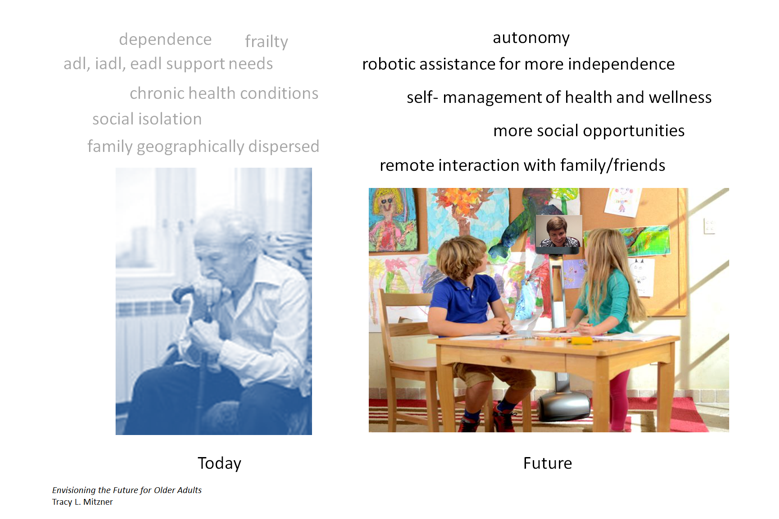
Extended Abstract: Who is the older adult of 2050? On many dimensions, future older adults will be similar to today. They will want to remain independent as long as possible. Many (currently 30%) will live alone in their own home and most will be managing multiple chronic health conditions with up to 40% having serious disabling conditions (Mitzner et al., 2014). They will need assistance with Activities of Daily Living (ADLs such as bathing, toileting), Instrumental Activities of Daily Living (IADLs such as preparing meals, managing medications), and Enhanced Activities of Daily Living (EADLs such as social communication, new learning). They will experience age-related changes in motor, perceptual, and cognitive capabilities. Although they will have experience with many technologies, there will be new developments that they will have to learn and incorporate into their daily routines.
Some differences in 2050 – the number of individuals over the age of 65 will almost double. They will have an active aging mindset; their approach to healthcare will be participatory; they will want autonomy, and will have a longevity focus. Given continued migratory patterns, family members will likely live long-distance and options for professional support may be limited due to financial constraints and workforce shortages. Thus, risk for social isolation may increase, which evidence suggests may impact their health negatively.
Consider this sample scenario:
Ronnie lives alone and needs assistance mostly with IADLs (meal preparation, medication reminders) and EADLs. She just had foot surgery so also has some temporary mobility challenges. Her family lives 500 miles away and her current ability to leave the house is reduced. She is less able to participate in her usual exercise class or meet friends. However, technological advances enable her to: actively engage with family and friends; meet her healthcare and nutritional needs; and ambulate easily around the house to tend to her personal needs. These supports are seamlessly integrated into her home, easy to use, and not intrusive:
- Her personal robot, GOBI, can order food online, based on Ronnie’s preferences and dietary restrictions. GOBI can then prepare meals on demand depending on Ronnie’s schedule for a particular day. GOBI ensures safety of food preparation, proper storage of leftovers, and cleans up after the meal. While Ronnie eats, she is connected via a telepresence system to her daughter’s home where her family is also having dinner therefore providing a community dining experience.
- GOBI reminds Ronnie to take her medications and brings her the required food and/or water. GOBI records when the medications were taken, side effects experienced, and effects on how she feels and on her vital signs. This information is incorporated into Ronnie’s health record which is updated and accessible to her healthcare team as well as to Ronnie to identify patterns of medication effects.
- Her exercise trainer/physical therapist supervises and monitors her exercise routine using a telepresence system attached to a device that accurately and precisely captures Ronnie’s movements.
- Her healthcare provider makes house calls via a telepresence system to monitor her overall health and examine her foot to ensure her surgical wound is healing well.
- Ronnie uses a robotic walker that helps her get out of bed or up from a chair, is small enough to fit into her bathroom, and is safe to use in the shower.
This scenario illustrates the potential for technology to support the diverse needs of future older adults. This would be a predictable scenario given the current trajectory of technology development. However, for this to be accomplished there remain important research and development efforts. Some of the groundwork has been accomplished but many design, training, deployment, and policy issues are yet to be addressed.
A more far-reaching and transformative scenario is represented below:
Dave lives alone in remote rural cabin in the northwest. He cannot drive due to vision limitations and the weather conditions often prohibit others from coming to visit. As a result he is rather isolated and has difficulty getting to appointments. He is in relatively good health but he does have a serious heart condition that requires continuous monitoring and periodically electrical stimulation.
- His transportation needs can be met in a variety of ways depending on the weather and his plans for the day. He can use the ride-share program to find out if any of his neighbors are going to town that week. Or he can reserve the autonomous car to take him on his errands.
- His telepresence system is a holograph that enables family members to visit “in person” throughout the day.
- Physical therapists visit him every day via touch transmission technology that enables them to remotely provide physical therapy and rehabilitation exercises that require hands-on manipulation and guidance
- His personal robot can perform medical procedures such as detecting heart rhythm irregularities and administering defibrillation in emergency situations.
- His everyday activities and physiological status are continually recorded and analyzed to predict functional changes and the need for technology interventions.
- Dave is in a high-risk category for depression, loneliness, and morbidity. Therefore his emotional state is assessed and evaluated for deviations from his personal norm.
This scenario is possible for the future but many more hurdles to be overcome before it would be realistic. There are technology challenges, insufficient knowledge of health trajectories, and the analytic side is underdeveloped.
This paper will describe aging trends in terms of characteristics of older adults and their needs and preferences for support, and will posit additional plausible scenarios for older adults of 2050, focusing on a variety of needs and home technology supports. We will specifically address the facilitators and barriers for the successful development and deployment of these technologies.
Participant Notes
Participants reacted very strongly to this paper, perhaps because aging is a condition we will all (if we’re lucky) experience. Some participants challenged the idea altogether, suggesting that the future population of elderly will be healthier and independent, citing current trends in the health and wellness of Baby Boomers. Below are some notes to the authors:
- If older adults do not live independently, how might the future of congregate living be transformed?
- As an alternative for now, use a drone. Smaller display, but now can go outdoors.
- Does the robot have a personality? Remember the robot on “Interstellar”? You could dial-up or dial-down the humor level.
- Customization – Acceptance – Flexibility
- Increasing independence through greater social access and mobility.
- Increased social connectedness via wireless technologies can decrease vulnerability during disaster recovery.
- Reintroduce the elder as sage storyteller. Respect for elderly renewed.
- Importance of trends to user family / caregiver.
- Can technology provide too much assistance? It could contribute to decline. Need mechanism to challenge user.
- Expensive – robots, telepresence, care network.
- New career – “tailoring your assistive ecosystem: at home, at work, and on the go.”
- Make sure family members and caregivers are also involved in the selection of assistive systems.
- Balancing privacy and independence.
- Leverage multi-modal capabilities of smartphones / tablets acting as controller, tied to sensors around the home.
- What about 70 as the new 60 – healthier, more active lifestyles, better meals [meds?] / diet. This tomorrow sounds like today.
- Have / have nots re: installed assistive systems? 2nd hand / used systems market? If so, what problems might that create?
- Personalization.
- Shareable robots in community – social /health.
- Solutions for elderly may often be similar to solutions for children – impact on tech adoption rates.
Accessibility in Disaster Conditions: transforming the cycle of emergency phases
Presented by Brenda Phillips, PhD, Ohio University - Chillicothe Authors: Brenda Phillips, PhD; DeeDee Bennett, PhD; Elizabeth Davis, JD
Extended Abstract: This paper takes a “flash-forward” approach to 2050 to show how thedisability reality has been transformed within the practice of emergency management. By describing a transformed life-cycle of emergency management, the paper re-envisions how emergency managers prepare for, respond to, recover from, and mitigate against disaster impacts. Each phase (preparedness, response, recovery, and mitigation) will be explained, discussed, and reviewed for the transformations that have occurred by the mid-century. As a counterpart, an alternate scenario is presented as a way to demonstrate how failures to change maintained levels of personal risk for people with disabilities and their communities.
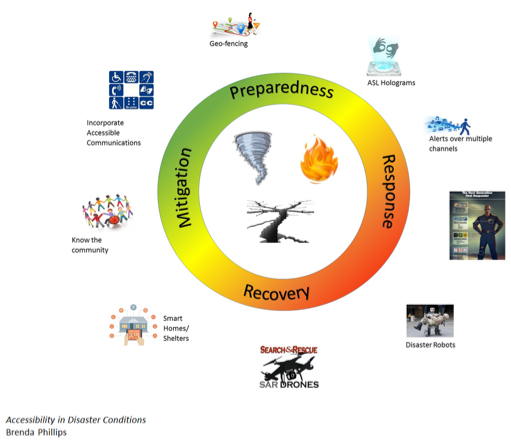
To illustrate, discussion over the four phases will include but not be limited to examples of real trends in emergency management such as the few listed below:
- Preparedness. How have wireless technologies enhanced preparedness efforts particularly outreach and education of people and communities with disabilities?
- Response. How have wireless technologies changed the warning process; sped the rescue process; as well as elongated sheltering practices?
- Recovery. How do wireless technologies enable location of accessible shelters and housing? Given the integration of accessible design elements, how have shelters and post-disaster housing become both physically and technologically-accessible?
- Mitigation. In what ways have new codes and standards for use of elevators (e.g., generators, safe shafts for evacuation and rescue), for example, and wireless technologies (among other features) become integrated into post-disaster reconstruction as a means to mitigate future risks for people with disabilities?
By using several real examples of trends and practices emerging in 2015 and carrying them through to 2050, we will show the potential outcomes if supported today. This will be woven through the groups of examples built into each phase illustration as listed above. Alternatively, a failure scenario will reveal the ways in which society, policy-makers, and individuals undermined the potential to build resilience with and for people with disabilities and their communities.
The paper will also review the transformative agents and conditions required for movement toward a newly-envisioned 2050. This section of the paper will rely on an eco-systems approach to reveal the agents of such transformative change, drawing from the examples used in the previous section. To illustrate, discussion will include but not be limited to:
- Micro-Level Change. Who were the change agents at the individual and household levels? Where did they come from? How did they effect such transformations? What were the roles of people with disabilities in promoting micro-level change?
- Meso-Level Change. Which inter- and intra-organizational arrangements led to new configurations of emergency management practice by 2050 (e.g., legal mandating of continuity of operations planning)? What were the roles of disability and accessibility organizations in meso-level change?
- Exo-Level Change. What kinds of innovative policies mandated or enforced transformative change (e.g., permitting prescription/insurance coverage of emergency stockpiles, and for devices used in an evacuation including wheelchairs and scooters)? How were the policies leveraged to modify realities of the early century? What policy modifications were required by the time that emergency management reached mid-century? What were the impacts of various types of disasters on policy-making? How did people with disabilities and disability organizations influence policy design and implementation?
- Macro-Level Change. How was a culture of prevention for people with disabilities achieved? For example, personal preparedness has become ingrained as a core value. What conditions fostered movement into a new future, such as demographic shifts, new economic circumstances, heightened risk awareness, or cultural adaptation? For example, preparedness has become part of the core curriculum from kindergarten through high school and all high school graduates are now required to take basic first aid. As another example, accessibility has become a way of life, with curriculum and first aid initiatives incorporating information and training on how to plan, prepare, and respond in an inclusive manner. How did various disasters influence awareness, increase funding for accessibility initiatives, and transform world views? What were the roles of people with disabilities and disability organizations in inspiring widespread social and cultural change?
The next section of this paper will take a few of the real world examples from each phase at the start of the paper, and then show the impact of the evolution of those outcomes by 2050 based on the interdependencies and interplay among the eco-systems. For example, if a new law is not passed requiring certain changes in prescription medication coverage a great level of the population still cannot afford to follow a basic tenet of personal preparedness to have a few days’ supply of medications available at all time. This, in turn, has a positive or negative impact across all the phases of a disaster.
This paper is designed to envision a transformed, mid-century view of emergency management and accessibility. Rather than just an optimistic flash-forward view, the paper will lay out the route most likely to lead toward such an outcome. As such, the paper will reveal a groundbreaking vision coupled with a guide that compels forward movement. The alternative scenario, starkly contrasts what could be with what might be if we fail to act.
Participant Notes
Disability in the practices of emergency management is explored, especially how technology can transform disaster response for people with disabilities. Below are some notes to the authors:
- Options to handle recharging cell phones when power is out.
- Self-driving cars that will pick up people with disabilities prior to or after emergency event.
- Buildings know of resident or visitor presence in emergency.
- Greater participation of people with disabilities in emergency planning design and implementation.
- How do you gain mass adoption of geo-fencing?
- Smart traffic flow in skyscraper evacuations.
- Low tech will always be in play.
- People with disabilities become an asset to the process – not viewed as liability.
- Wireless RERC studies show affordability is close to a non-issue.
- Mobile / wearable to locate and understand specific need of person in disaster.
- Internet of things may help connect first responders with victims with disabilities during response.
- Everyone has a location beacon on them so they can be located in any emergency disaster situation.
- Environments adapt to the person – it’s mutable.
- Maze of government funding.
- Greater focus in “recovery” periods on gathering “lessons learned” and sharing that info with manufacturers.
- Recovery – what about digital design of replacement homes and schools and businesses driving architectural 3D printers for faster rebuilds?
- Interoperability extending into culture of use.
- Biometric identification of at-risk persons, triage and priority.
- Specialized and coding lighting can be used for multiple warnings. Lights like “Hue” can change colors to indicate different warnings.
- Geo-fence logical ranges for context.
- Information to assist people with disabilities as threats to privacy? Tension?
- Cheap two-way sensors: send data to hub – temperature for fire, mic for listening for cries of help, and smoke. Relay – send Bluetooth message to accessibility device for emergency messaging.
Personalizable Wireless Technologies and Standards for Improved Access
Presented and authored by Markku T. Hakkinen, PhD, Educational Testing Service (ETS)
Extended Abstract: Personalization is the hallmark of the next revolution in accessibility, driven by the ability to customize technology, and specifically, mobile, wireless devices. The impact on education for all students, teachers, and content authors will be one that creates new opportunities for personalized, accessible learning. The concept of personalizing information technology emerged for the mainstream with the advent of the mobile phone, initially through the simple mechanism of custom ring tones and vibrations through the current ability to customize appearance and functionality of a tablet or smart phone through the use of apps. While adoption of tablet devices is increasing in education, and an ecosystem of learning apps and eTextBooks has emerged, it can be argued that the full potential of these devices is yet to be leveraged.
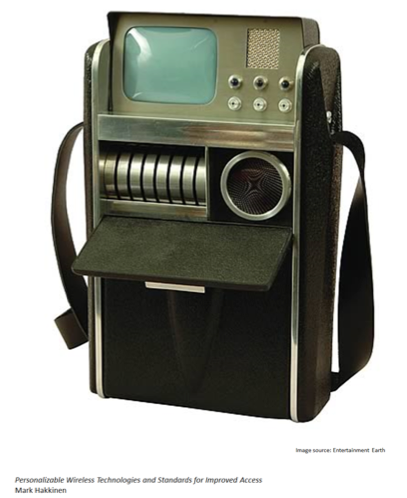
For students with visual impairments, for example, off the shelf consumer tablet devices that incorporate built-in accessibility tools, such as a screen reader and support for refreshable braille displays already offer advantages when compared to traditional technologies, such as personal computers and expensive, third party assistive technology applications. But mobile devices are incorporating powerful technical capabilities in the form of sensors and connectivity options that can enable all students, including those with physical, sensory and cognitive disabilities to interact with their environment in ways that may seem out of science fiction, but in fact are already around the corner. The original Star Trek series envisioned a 23rd century device known as the Tricorder, a tool for examining and learning about the environment. Seeing the next iteration of mobile devices reaching into the territory of the tricorder is exciting, especially if accessibility is a core feature. Apps already enable standard smartphones to identify colors, recognize text, determine geolocation, measure pulse and respiration rates, motion, and even atmospheric pressure. Using Near Field Communication or Bluetooth, Smartphones can communicate with the Internet of Things, whether they are lab instruments or museum exhibits. When the device capabilities reach their limits, the cloud can draw in additional resources, including computation and crowd-sourced sourced human assistance.
And the ways we interact with the devices themselves are evolving from the basics of touch and spoken interaction to gestural, eye-gaze, and brain-computer interfaces, with contextual adaption driven by location, task, time and user preferences. Adaptability of the device is key, as is the resultant ability to support the unique needs of each user.
For students, these devices enable learning in and out of the classroom, augmenting traditional instruction and providing the opportunity to study the world around them. eTextBooks will merge into interactive learning experiences, that engage (and measure engagement), assess, and adapt to meet the needs of the student.
Technical standards that promote and enable accessibility will be key in enabling this vision. Ensuring that devices and content support information consumption and interaction across modalities, displays, and inputs will allow all students, irrespective of ability or disability to benefit.
Participant Notes
For this paper, focus moved the discussion toward market driven innovations and open (i.e. free) standards. Also addressed was the assumed impending ubiquity of wearable technologies and the Internet of Things. Below are some notes to the author:
- Pro-sumer design >>> get users, especially kids, to show how they’re adapting common tech to assist them: open source standards.
- Simulated / virtual labs as “second best” vs. real, hands-on labs and learning.
- Tangible technology in learning (including low-vision or blind).
- The “independence scenario” suggests that the growing, ageing population, having grown up with mobile technologies will be both advocates and beneficiaries of new technologies. But each successive generation finds itself somewhat challenged by non-native technology.
- Professional test takers (for certification exams) worry about stigma of using assistive technology – how to resolve this?
- Will view of testing change if wearable augmentations become more ubiquitous? What’s allowed decades from now?
- The objects in our world will all be talking to each other. Will they be able to spot / diagnose emerging problems people are having?
- Importance of open source for standardization.
- “Black Mirror”
- Commercial solutions must still be profitable – that builds the marketplace.
- Centralized pooling and sharing of ideas – knowledge databases available to caregivers > “how to educate” of currently available options.
- Shift in expectations and demand.
Change Process Factors
Making Design Accessible
Presented and authored by Joshua Cole, Engineer & Inventor
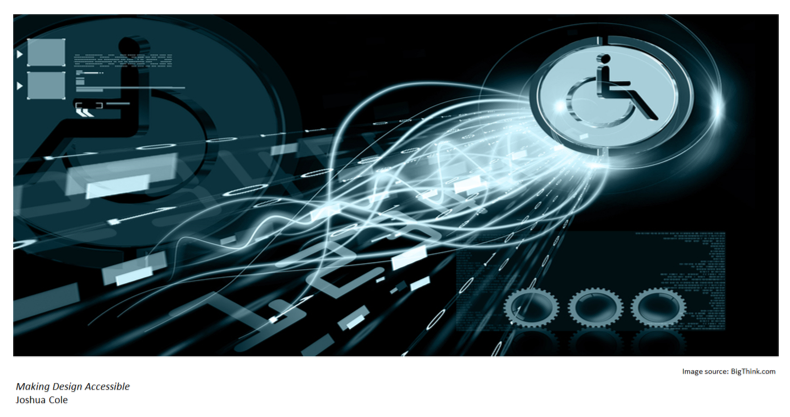
Extended Abstract: Fifty years ago it seemed unlikely that consumers would one day be able to build a computer at home, but as the components became both modular and affordable the design of the personal computer passed partly to the end user. A decade ago the prospect of a consumer manufacturing plastic components in their home was just as implausible, and now 3D printers are on the verge of becoming a common household appliance. As technology evolves, the role of specialized knowledge to create devices and systems that leverage that technology diminishes, shifting the center of design away from the etic professional and toward the emic non-professional. In a world where persons without accessibility challenges have already begun to participate in this emic design process, the goals of access and assistive technology programs and proponents must shift toward ensuring that the underlying fundamental technology that allows such emic design is itself accessible.
This need is perhaps most easily observable in the mobile application space, where visual programming environments and “app creation” programs allow the creation of mobile applications and games without requiring literacy in (or even awareness of) the programming language itself. Skilled programmers (the etic) are no longer required to make relatively simple applications based on predefined libraries of code, but they are still required to create the environment and tools in which non-programmers (the emic) may develop these applications on their own. Those persons, so enabled, can thereby meet their existing needs more easily, and should they so desire still invest the time to learn the programming language itself at their own pace, because their initial success is no longer bound to that understanding. The future of accessible programming must take advantage of the same concepts, providing ease of entry into the design process by enabling programmers regardless of access needs.
Another key point of entry for persons with access needs in this new paradigm is the increasing use of natural language user interfaces in machines. The natural language text to speech and speech to text engines that power search, navigation, and UI products in consumer and mobile electronics are to some extent dependent on the input method for which they are optimized, and current implementations are fragmented by use case; as image processing, computational power, and bandwidth continue to increase the ability of these engines to interpret ASL, eye movement, and signals from electrooculography and other human input mechanisms will also become viable. Natural language interface, already an essential component of mobile technology, will also be a preferred method for interacting with consumer robotics, transportation systems, and automated transactional systems like ATMs and kiosks.
Finally, the interaction between more accurate biometric systems and increasingly standardized open authorization and authentication systems will allow consumers to declare access needs to potential devices automatically via their own personal electronics products, their preferences passed machine-to-machine by the exchange of secure tokens in lieu of personal data.
Participant Notes
For this paper, participants were excited by the prospect of increasing the participation of people with disabilities not only in the design process, but as designers and engineers themselves. Below are some notes to the author:
- How can technology be used for participatory design – e.g., telepresence systems?
- Aesthetics and acceptance in accessible designs.
- Sound visualization of data – Scientific American.
- Accessible design – how to make tools accessible.
- Gaining access to PWD for product testing due to privacy constraints.
- Developing a shared framework for blending emic and etic views.
- Participatory design? Action research?
- This is a fundamental paper to this conference, in that it explores the impact of disruptive tech, i.e., “augmentative” vs “assistive” technology. How might this shift affect people whose identities are culturally vested in disability, eg, “The Deaf”?
- If we mitigate a disability with technology, do we diminish them as a person?
- Does technology make the disability irrelevant?
Making Design Accessible
Presented and authored by Joshua Cole, Engineer & Inventor
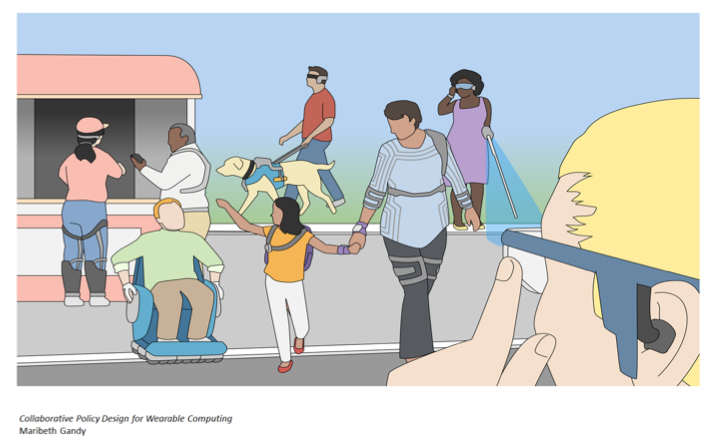
Extended Abstract: The declining cost and increasing processing power of digital and communications technology are reshaping the image of wearable computing devices (wearables), from science fiction devices, to very real artifacts with the promise of significantly impacting the lives of consumers. The capacity of the devices, both as sensors, as well as to provide feedback to users of both personal data, and environmental data is both intriguing in turns of opportunities, and formidable in turns of social, and cultural consequences. Coupled with the changing role in which technology facilitates life functioning and community engagement, these devices represent new options beyond simple assistive and facilitative technologies, for people with disabilities to engage in community participation. However, designers, technologists, and policymakers operate independently with the consequence of products that are out of sync, lack interoperability, or are hindered by well meaning, but obstructive policy.
The developers of wearables, by necessity, are concerned with the specifics of the technology and the ways in which wearable computing interacts with other components of the system. With the exception of regulatory requirements, policy considerations tend to be more focused with the impact of the object’s functioning on common public resources (e.g. wireless spectrum) and its interactions within the broader social context in which these things occur.
This paper explores possible futures that could impact the design and deployment of wearable technologies, and that in turn, might be possible by various iterations of wearable development. We explore the idea of using a futures approach to enhance development of collaborative policy design framework that could facilitate the development of inclusive wearable computing devices.
Participant Notes
The focus on possible futures where various iterations of wearables can facilitate the development of inclusive wearable computing devices is explored. One provocative theme of the participant responses centered on the disappearance/de-stigmatization of disability due to all humans desiring augmentation of their humanness with wearable technology. Below are some notes to the authors:
- Preferred outcomes are personal.
- Guiding wearable policy >> get in front of policy roadblocks that might interfere with rollout.
- Wearables should be transparent for the user >>> no need to think.
- Personalizable not obviously augmented – super human.
- Digital divide and wearables.
- From dis*abilities to hyper*abilities?
- What is being done to make wearables affordable?
- Can you tie in open source ideas / policy?
- Disability disappears.
- Does augmentation level the playing field, rendering competition moot?
- Is technology augmentation “the new plastic surgery”?
- Use of sensors being sent back to central databases for 1) data collection >>> learning; and 2) triggering alarms for caregivers.
- Policy issue >>> privacy concerns on individual vs shared data.
- You are already part of the natural environment (as the human animal). You will also be part of the built and information environments (as the human cyborg and human data stream). Vulnerabilities? New digital pandemics; new terrorist hacks. System will also require localized micro-generation of energy.
- Yes – everyone is augmented and hence maybe the people with disabilities stigma goes away.
Scientific Eventuality or Science Fiction: The Future of Disability
Presented and authored by DeeDee Bennett, PhD, University of Nebraska – Omaha
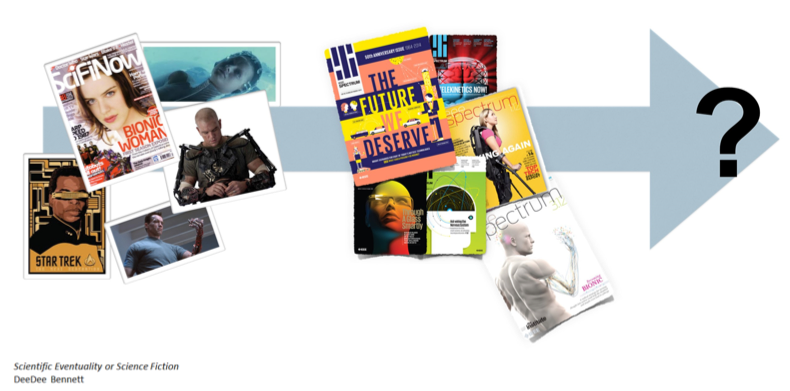
Extended Abstract: Consider this, as seen and read from science fiction, we are living in a future [in-part] imagined over 30 years ago. One may envision that 30 years from now we could live in a future with technology developed from the concepts we see in science fiction today. In this paper, I seek to challenge the concept of disability in the future, based on the technologies imagined in present and past science fiction-based books and film. In fact, the present term disability has been seen to characterize people based on their inability to do something. Perhaps the use of wireless technologies may enable a traditional person with a disability to no longer be classified in the same way. One of the most popular examples is from Star Trek (1987), in which previously blind Lt. Geordi La Forge acquired different sight abilities with the use of a special pair of glasses called, VISOR. With the use of VISOR, Lt. La Forge is able to ‘see’ but not how we typically see, instead the glasses gave him the ability to detect energy wavelengths of animate and inanimate objects allowing him to effectively complete his engineering job. If our past is any indication, our future may lie in the conceptual and slightly implausible figments of our science fiction-based imaginations.
Several compelling articles have been written to compare, discuss and forecast our progress in technology and how that will impact our perception with regards to gender, multiculturalism, geography and disability (Nixon, 1992; McCallum, 2000; Kitchin & Kneale, 2001; Chilcoat, 2004; Moser 2010). With regards to geography, McCallum (200) reviewed several science fiction works to examine geography only to find that science fiction does not provide a futuristic model of geographic spaces, as assumed. Kitchin and Kneale (2001) note that critical review of cyber fiction (a sub-genre of science fiction) is important as it may provide visualizations of our future, or derivations of it, with regards to geography of urban areas. For example, science fiction has been used by urban planners as a model for future geographical spaces. KItchin and Kneale (2001) cite a public lecture by urban planners in 1990 who would have liked to model future Los Angeles based on the visual representations presented in the cyberpunk film Blade Runner (1982).
A couple of authors discuss the role of gender in science fiction; Nixon (1992) concludes that cyberpunk (a sub-genre of science fiction) does not provide revolutionary ideas with regard to gender politics. Similarly, Chilcoat (2004) reviews cyberpunk cinema and the constraints on traditional gender roles, feminism and gender finding that the traditional roles remain. Finally, one author, Moser (2010), attempts to define what it means to be human, able-bodied or disabled. In one section, she reviews the cyberpunk cult classic “The Neuromancer” by William Gibson and concludes that cyber culture does not negate disability, however, it provides augmentations and extensions to human ability. These enhancements still do not challenge or change what it means to be disabled.
While Moser (2010) examined the concept of disability through science fiction by reviewing “The Neuromancer,” I will review the prospective evolution of technology as presented in several science fiction works to determine the future tech enabled human abilities that may facilitate better community living, increased employment and/or improved health for people with present day disabilities. Using a slight variation of Bradley’s (2006) Convergence Theory on Information and Communications Technologies (ICT) and Psychosocial Life Environment, I seek to answer the following research question: what do the wireless-based technologies imagined in science fiction yesterday and today tell us about the potential use of these technologies for people with disabilities in the future? Convergence theory looks at the interaction between globalization, ICT, life environment and life roles to “explore the human side of societal change taking advantage of technology to shape a good and balanced life (Bradley, 2010, p. 189).” Bradley uses convergence theory to examine the use of ICT such as computers, telephones, and the media (2010). In my variation, I look at the interaction between possible ICT and wireless technologies, life environment and human beings presented in science fiction films, TV series and books to forecast a potential future with greater respect for diversity. Furthermore, I am not limited to technology by which humans interface, instead I seek to include wireless technologies that are implanted or injected into human beings, as well.
For this conceptual paper, the exploration is limited to science fiction works, set in relatively near future fictional time periods, which incorporated ICT into the story plot and have the potential to influence our perception of human ability and thus disability. Therefore, I only focus on the science fiction sub-genre cyberpunk. As a genre, science fiction is segmented into multiple sub-genre, such as space exploration, time travel, fantasy, supernatural, superhero, or military, and there are several more. Not all of the sub-genres showcase the use of information and communication technologies (ICT) for a near-term future. Cyberpunk is a term used to define the sub-genre of science fiction that is set in the near future and often includes advances in ICT (Nixon, 1992; McCallum, 2000; Kitchin and Kneale, 2001). The overall setting for many cyberpunk books or film is that of dystopian rather than utopian societies (McCallum, 2000). Often in cyberpunk, the manipulation, implementation or enforcement of ICT was the cause for the apocalypse or the means to utopia.
Many popular films fit into this category including Robocop (1987), Minority Report (2002), and I, Robot (2004). In the last ten years, this genre is continuing with Surrogates (2009), Elysium (2013), and most recent Automata (2014). Additionally, TV series have been developed that fit this category, such as Caprica (2010) and Continuum (2013- present). Several novels have been written in this category, however, “Snow Crash” by Neal Stephenson (2000) and “The Neuromancer” by William Gibson (1986) are on most top cyberpunk books list. ICTs are an integral part of the plot in each of these cyberpunk works. In each of the films alone, Robocop (1987) introduces the idea of implantable computers in humans. Minority Report (2002) shows how the progressive use of ICTs in society can enable an authoritarian state. I, Robot (2004) challenges the intelligence of assistance robots and help us visualize transportation with autonomous vehicles. Surrogates (2009) propose a society in which robots are used as avatars. Elysium (2013) suggests a new type of society where most poor live on earth and the elite live in orbit. Using the cyberpunk sub-genre as a basis upon which to explore, I will examine the potential future of wireless technologies that can be used to challenge our current perceptions of human abilities.
Participant Notes
- The role of science fiction and science facts, can they add richness for people with disabilities? The topic, among others, is explored. Below are some notes to the author:
- Change the image >>> transform the future!
- Yes, science fiction movies, TV shows, etc. inspire folks to say I want that too! Maybe the future is ahead of the curb >>> development.
- Star Trek notable because of technological optimism.
- Importance of science advisors to artists.
- New awesome abilities.
- Environmental detection: assess the world around you and adapt.
- Is the exchange of ideas two-way? Fiction writers read about science, then write about science, which in turn influences science.
- Transporters for people with disabilities trapped on high-rises? Make it so!
- What are some ideas for influencing artists, writers, and designers to consider the needs of people with disabilities? How about encouraging people with disabilities to be among these professionals?
- Consider social media memes.
- Use crowd-sourcing to filter for pre-emergent invention. Targeted: state problem. Non-targeted: from the field.
- “Black Mirror,” BBC
- Look up Transcense.com – one programmer is deaf. Great solution.
- Influencing the “artistic imagination” to anticipate accessible environments including cultural attitudes.
- Should we give preference to inspiration by an enlightened vision of disability vs. a sci-fi futures (i.e., user-driven vs tech-driven design)? “Design meets Disability” by Graham Pullin is a good example of this vision of the future.







